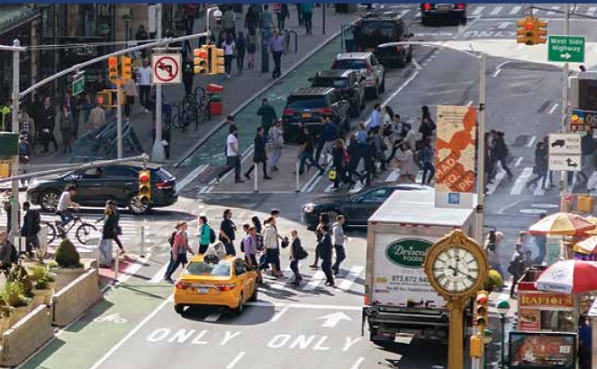ITSdigest
In 2017, New York City experienced its safest year on record with the fourth straight year of fatality declines, according to NYC's Vision Zero Year Four Report.

Since the program’s inaugural year in 2014, when New York City became the first American city to adopt Vision Zero, the city’s traffic fatalities have declined 28 percent with a 45 percent decline in pedestrian fatalities — bucking national fatality trends, which have increased 15 percent over the same period
The report outlines "how the City is changing drivers’ behaviors behind the wheel, cracking down on dangerous driving, and redesigning streets to make them safer for pedestrians and bicyclists — all through a combination of data analysis, engineering, outreach and education, enforcement, and new technology."

The report highlights several ways NYC is embracing ITS safety technology:
■ MTA has equipped 285 buses along several routes with a Pedestrian Turn Warning System, which sends an audible voice alert to pedestrians when a bus is making a left or right turn.
■ MTA has also equipped 145 buses with a Collision Warning System.
■ NYC Department of Citywide Administrative Services (DCAS) ensures that all vehicles purchased for Fiscal Year 18 and beyond must include the best available safety technology including, where applicable, automatic emergency braking, rear and side truck guards, and back up cameras.
■ NYC Taxi and Limousine Commission (TLC) established the Vehicle Safety Technology Pilot Program. Participants tested passive technology, such as camera systems and monitoring devices that track driver behavior, as well as active devices, such as driver alert and collision warning systems. Program findings are expected to be released in 2018.
■ In 2018, DCAS will upgrade the City’s telematic technology, first introduced in 2014 as part of Vision Zero, to provide better real-time reporting and improved functionality.
■ NYC is also one of three USDOT Connected Vehicle Pilot locations. Up to 10,000 taxis, buses, commercial trucks, and City-owned vehicles fitted with the new connected vehicle and mobile device technology receive communications that assist with speed compliance, red light violation warnings, blind spot and lane change warnings, emergency alerts, and other aspects of safe driving.




